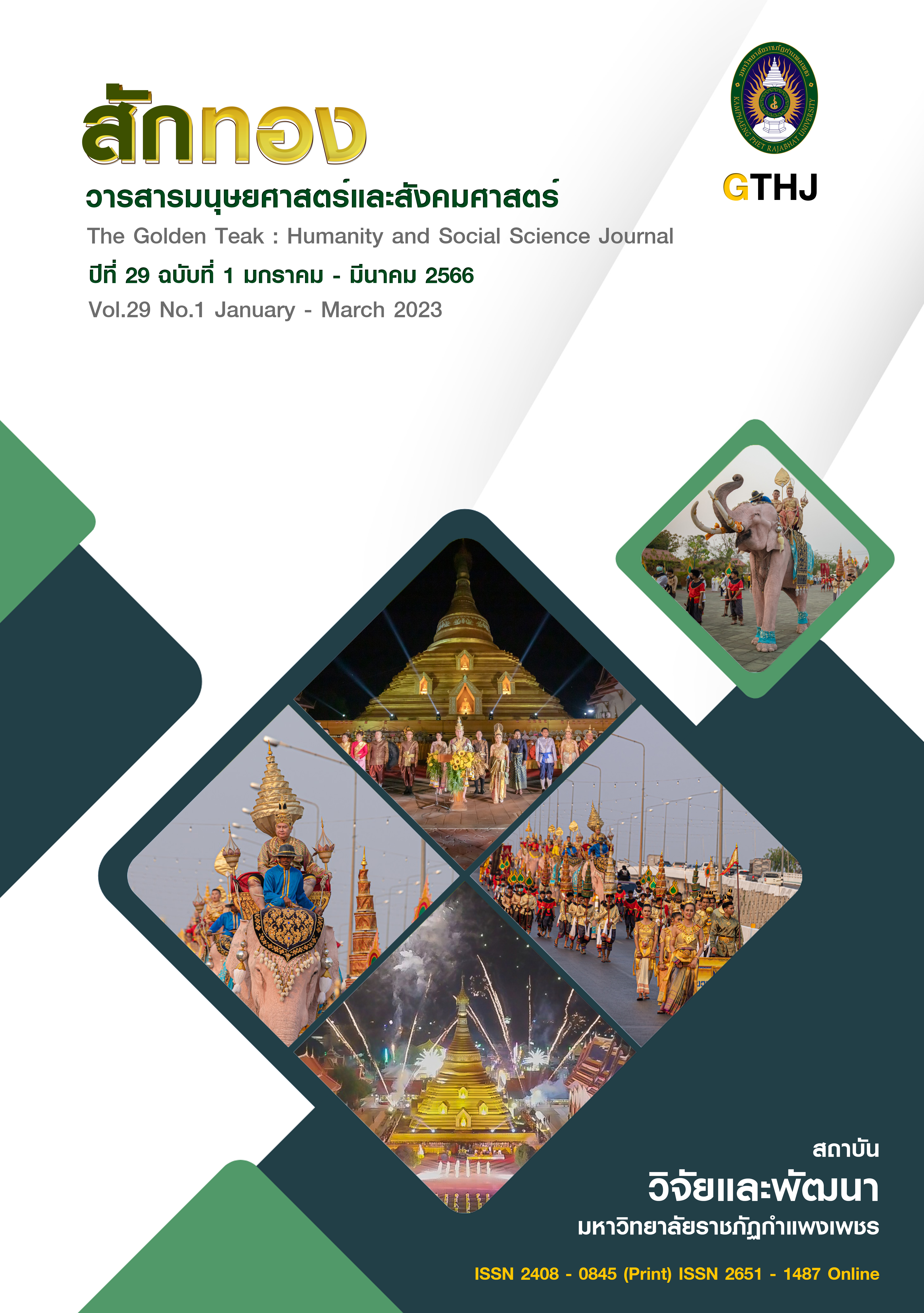A Corpus-Based Study of TOEIC Listening Vocabulary for Developing TOEIC Listening Word List for the Listening Exam
Main Article Content
Abstract
The objectives of this research to study the types and levels of vocabulary found in the TOEIC English test (Listening Part) and to select the words found and present them as a set of vocabulary for preparing English teaching materials. Vocabulary resources were English TOEIC tests from three books is Barron's TOEIC Practice Exam, Kaplan's TOEIC Listening and Reading Prep Plus, and Longman Preparation Series for the New TOEIC Test-More Practice Tests. The Listening Part sections of each of these textbooks was analyzed using corpus-based research tools. These tools were the concordance package (Concordance: AntConc) and the VocabProfile program, which helped to classify vocabulary lists. Additionally, word lists were constructed based on the findings discussed in Laufer (1989) in which a lexical coverage of 95% was considered necessary to ensure comprehension. The research results revealed that the total number of content words across the three textbooks was 3,987. The majority of these terms appear in the General Word List (GSL), and the average CEFR vocabulary difficulty level is B1. Furthermore, following the 95% criteria, a total of 3,788-word lists were obtained from the 3,987 content words. Vocabulary lists have been classified into 2,229 General Vocabulary (GSL), 382 Academic Vocabulary (AWL), and 1,177 OWL-OFF LIST, and the majority of these lists have been assigned a B1 level. These vocabulary lists can be used for developing content for English language teaching materials, and for developing word games that learners can use to develop their vocabulary knowledge according to the types of vocabulary or CEFR difficulty level.
Article Details

This work is licensed under a Creative Commons Attribution-NonCommercial-NoDerivatives 4.0 International License.
บทความที่ได้รับการตีพิมพ์เป็นลิขสิทธิ์ของวารสาร สักทอง : วารสารมนุษยศาสตร์และสังคมศาสตร์ สถาบันวิจัยและพัฒนา มหาวิทยาลับราชภัฏกำแพงเพชร
ข้อคิดเห็นใดๆ ที่ปรากฎในวารสารเป็นวรรณกรรมของผู้เขียนโดยเฉพาะ ซึ่งมหาวิทยาลัยราชภัฏกำแพงเพชรและบรรณาธิการไม่จำเป็นต้องเห็นด้วย
References
Anthony, L. (2020). AntConc (Version 3.5.9) [Computer Software]. Tokyo, Japan: Waseda University. Available : https://www.laurenceanthony.net/software. [2021, August 28].
Biber, D., Johansson, S., Leech, G., Conrad, S. & Finegan, E. (1999). Longman Grammar of Spoken and Written English. England : Longman.
Bunyarat, P. (2020, July-December). A corpus-based study of specialized vocabularies in industrial work for developing industrial word lists of English for science and technology class. Journal of Language, Region and Culture, 9(2), 123-151. [In Thai]
Cobb, T. (2021). Web Vocabprofile, an adaptation of Heatley, Nation & Coxhead's (2002) Range. Available : http://www.lextutor.ca/vp/ [2021, August 31].
Coxhead, A. (2000). A New Academic Word List. TESOL Quarterly, 34(2), 213-238.
Coxhead, A. (2002). The Academic Word List: A Corpus-based Word List for Academic Purposes. [Online]. Available : https://www.wgtn.ac.nz/lals/resources/academicwordlist/information [2021, August 31].
Chula Book Center. (2020). Practice Test TOEIC: Preparation before Taking the Exam. [Online]. Available : https://www.chulabook.com/th/news/304. [2021, August 12].
Education First EF. (2020). What is the CEFR?. [Online]. Available : https://www.efset.org/th/cefr/ [2021, August 18].
Education First EF. (2020). The CEFR and EF SET. [Online]. Available : https://www.efset.org/th/cefr/intermediate-english. [2021, August 18].
Education First EF. (2020). Examinee Handbook for TOEIC Listening-Reading. [Online]. Available : https://www.ets.org/s/toeic/pdf/examinee-handbook-for-toeic-listening-reading-test-updated.pdf [2021, August 18].
Ghadessy, M. (1979). Word Lists and Material Preparation. A New Approach English Teaching Forum, 17(1), 24-27.
Halim, S.W. (2018). Lexical richness in English Language and Culture Department Students’ Undergraduate Theses. Journal of English Language and Culture, 8(2), 140-151.
Heatley, A., Nation, I.S.P. & Coxhead, A. (2002). RANGE and FREQUENCY programs. [Online]. Available : http://www.victoria.ac.nz/lals/staff/paul-nation.aspx. [2021, August 18].
Laufer, B. (1989). What percentage of text lexis is necessary for comprehension? InC. Lauren & M. Nordman (Eds.), Special language: From humans thinking to thinking machines(pp. 316-323). Bristol : Multilingual Matters. [Online]. Available : https://www.lextutor.ca/cover/papers/laufer_1989.pdf. [2021, August 16].
Nation, I., & Hunston, S. (2013). Vocabulary and listening and speaking. In Learning Vocabulary in Another Language (Cambridge Applied Linguistics, pp. 161-203). Cambridge : Cambridge University Press.
Nation, I.S.P. (2001). Learning vocabulary in another language. Cambridge : Cambridge University Press.
Safari, M. (2018). Do University Students Need to Master the GSL and AWL Words? A Psychology Word List. [Online]. Available : file:///D:/KOB%20DATA/Download/1%20(2).pdf. [2021, August 16].
Soranasathaporn, S. & Tampanich, S. (2016). High Frequency Word List in Laboratory Animal. Review Articles. Language and Linguistics[Online Serial], 35(1). Available : https://so04.tci-thaijo.org/index.php/joling/ article/view/126645 [2021, August 16].
Stæhr, L.S. (2008). Vocabulary size and the skills of listening, reading and writing. Language Learning Journal, 36(2), 139-152.
Towns G. Stuart. (2020). Which Word List Should I Teach? Using Word Lists to Support Textbook Vocabulary Instruction. THAITESOL Journal, 33(1), 20-35.
Thornbury, Scott. (2002). How to teach vocabulary. England: Pearson Education Limited. Webb, S.A. (2008). Receptive and productive vocabulary sizes of L2 learners. Studies in Second Language Acquisition, 30(1), 79-95.
West, M. (1953). A General Service List of English Words. London: Longman, Green & Co.
Wudthayagorn, J., Pugsee P., Janpugdee, P. & Limgomolvilas, S. (2021). A Study of the Information and Communication Technology Word List. PASAA PARITAT JOURNAL[Online Serial], 35. Available : https://so07.tci-thaijo.org/index.php/P asaaParitat/article/view/1019/726 [2021, August 16]. [In Thai]


